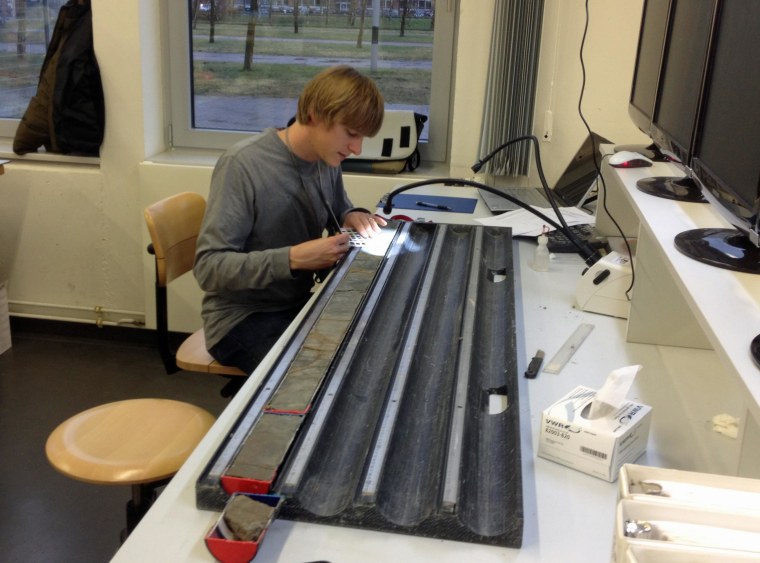New data from the Earth’s last big warmup, some 56 million years ago, may offer a sneak peek into what today's climate change may eventually look like.
Scientists have determined that the rate at which carbon emissions heated up the planet during the late Paleocene is much more similar to modern human-caused warming than many experts previously thought, a new report published Monday in Nature Geoscience shows.
The good news, the researchers say, is that most of the species around at the time survived the Paleocene-Eocene Thermal Maximum, or PETM, although many had to migrate. The bad news: It took nearly 200,000 years for the Earth to recover from that warming, in which temperatures rose by 9 to 15 degrees Fahrenheit (5 to 8 Celsius).
And the scientists found evidence of two carbon releases, with a bigger one following the first, a possible sign of a triggering mechanism.
“If you’re looking for an ancient analogue to what is happening now to see how bad it’s likely to be, this is the whole thing,” said Richard Norris, a professor of paleobiology at the Scripps Institution of Oceanography at the University of California, San Diego, who is unaffiliated with the new report. “You can see how the event played out. So, in that respect, showing that this ancient event occurred rapidly is an important finding.”
Drilling way down
To look at the historical climate, University of Utah researchers drilled down more than 1,200 feet in Wyoming’s Big Horn Basin and extracted cylindrical sections of rock called core samples.
“We are looking at a basin in Wyoming that is next to Yellowstone,” said the study’s lead author, Gabriel Bowen, an associate professor of geology and geophysics at the University of Utah. “It’s an outstanding place to look at this period of geologic history because the mountains were actively rising and they formed a bowl into which all rock material from weathering in the mountains flowed. There was a rapid accumulation of sediment being deposited in episodic floods. And during quiet periods soil formed. Those soils are what we are studying.”
The rate at which carbon was being released leading up to the PETM was pretty close to the rate being released now, which is 20.9 trillion pounds (9.5 petagrams) per year, the researchers found.
“We are doing some crazy things with the carbon cycle,” Bowen says. “Carbon naturally moves back and forth between rocks and the atmosphere at a steady slow rate. What we are doing by burning fossil fuels is accelerating the pace by about 30 times over the natural rate.”
The effects during the PETM weren’t limited to temperature. “There were big changes in the water cycle,” Bowen says. “For some regions there were really severe extreme precipitation events, and in some, like Wyoming, there was aridification.”

Two pulses of carbon
Intriguingly, Bowen and his colleagues determined that there were actually two releases of carbon into the atmosphere, one before the PETM and one shortly after it started.
And that may be a sign of scary things to come.
“One possible explanation is that the first, the smaller one, caused some climate change that triggered a second one,” Bowen said. “So it’s possible that the current pulse we are adding to the atmosphere may trigger unanticipated feedbacks that might lead to warming that could last hundreds of thousands of years.”
That first release of carbon could have been the result of volcanism, Bowen says. And that might have caused the oceans to warm, which could have led to the melting of methane that lies in frozen deposits on the sea floor. And that could have accounted for the second pulse.
“We don’t need a ton of warming for that to happen,” Bowen said. “That’s a little scary.”
The methane melting scenario makes a lot of sense, says Baerbel Hoenisch, an expert in paleoclimatology and an associate professor of earth and environmental science at Columbia University’s Lamont-Doherty Earth Observatory.
“If the frozen methane gas gets released it won’t leave a trace,” said Hoenisch, who is unaffiliated with the new study. “Like ice that melts, it’s just not there anymore. That’s why we can’t say with all certainty what the cause of the event was. But it’s quite cool that they found the two peaks.”
Problems for the oceans
Although there weren’t a lot of extinctions of land animals, about 50 percent of the foraminifera became extinct during the PETM. “Most people won’t care about foraminifera,” Hoenisch said. “They are single cell organisms that are at the bottom of the ocean’s food chain. But if you take those away, there are repercussions at the higher levels of the ecosystem.”
Another problem that developed during the PETM was acidification of the oceans, Norris said. The result: coral reefs died off. “They disappeared for about 10 million years and they didn’t come back until the planet began to cool,” Norris added. “Coral reefs are already having trouble now. So that’s a sobering thought. We may not have reefs around the planet much longer.”
One big difference between then and now: There weren’t a lot of species around that needed a cold climate, Norris said. So, tropical animals and plants could just relocate to northern climates. Now, we have polar bears, whales, penguins and other species that live in the Arctic and Antarctic.
“Those ecosystems are being profoundly affected by what is happening now,” Norris said.